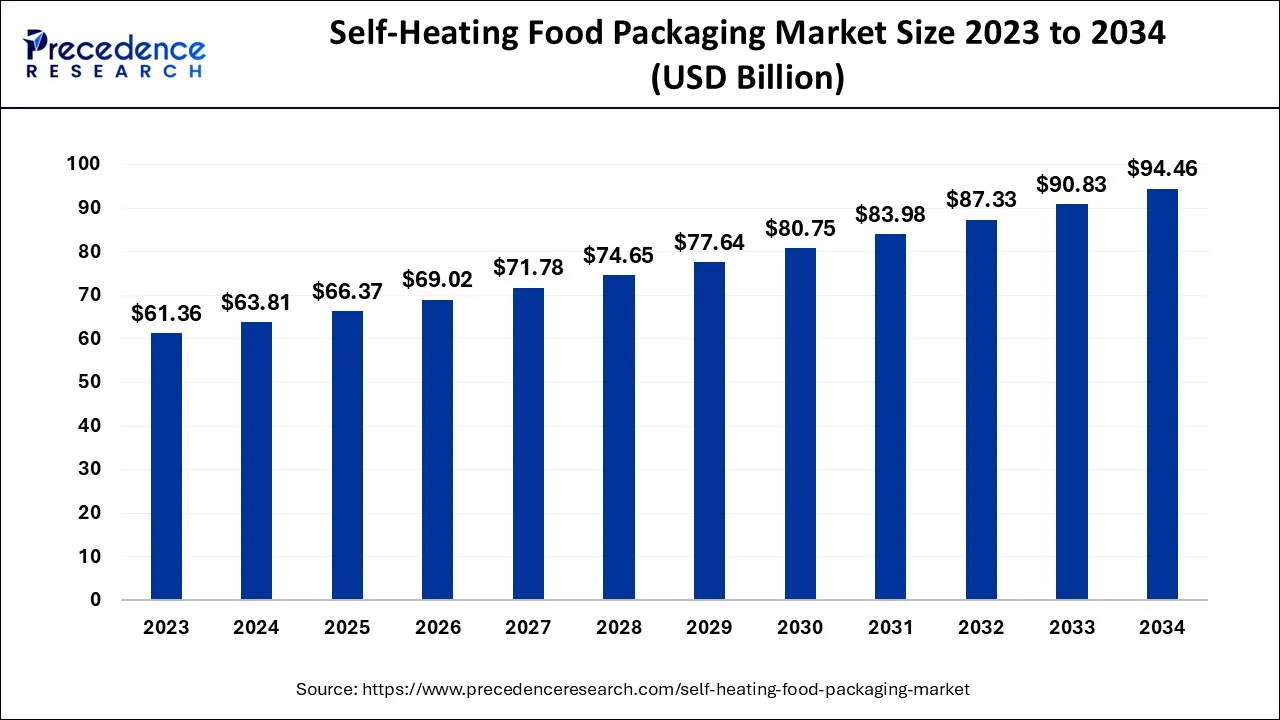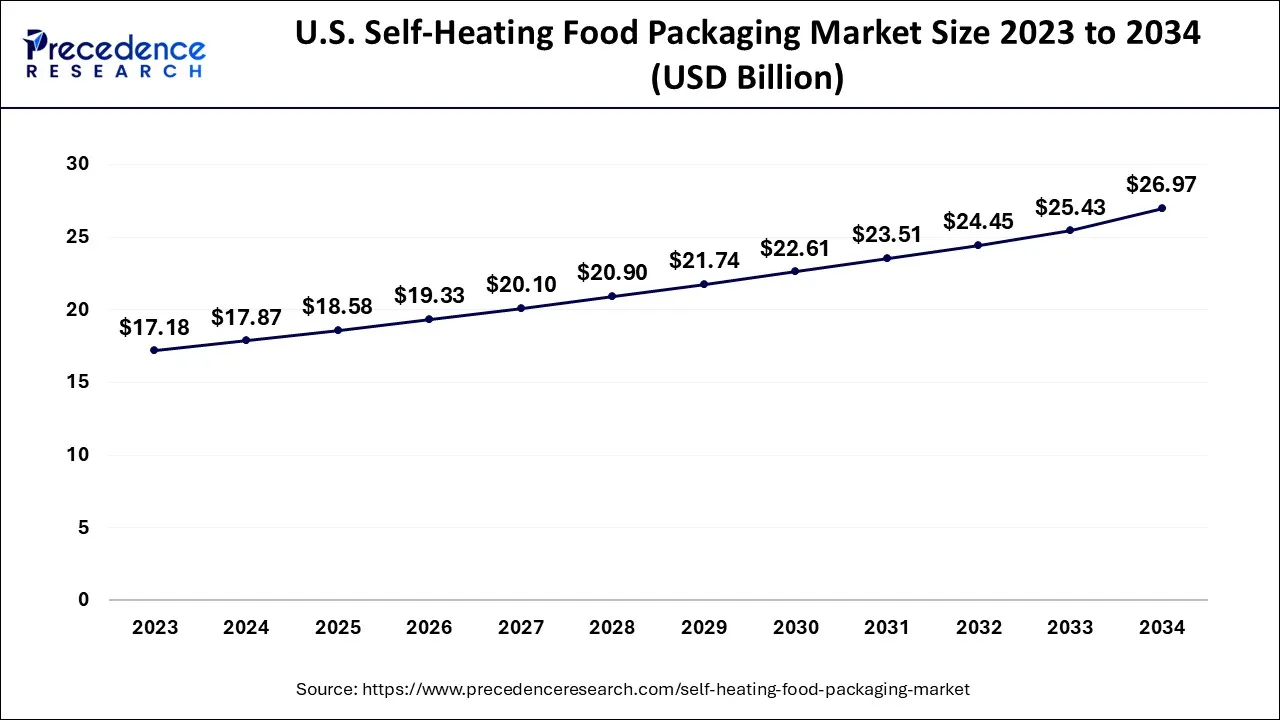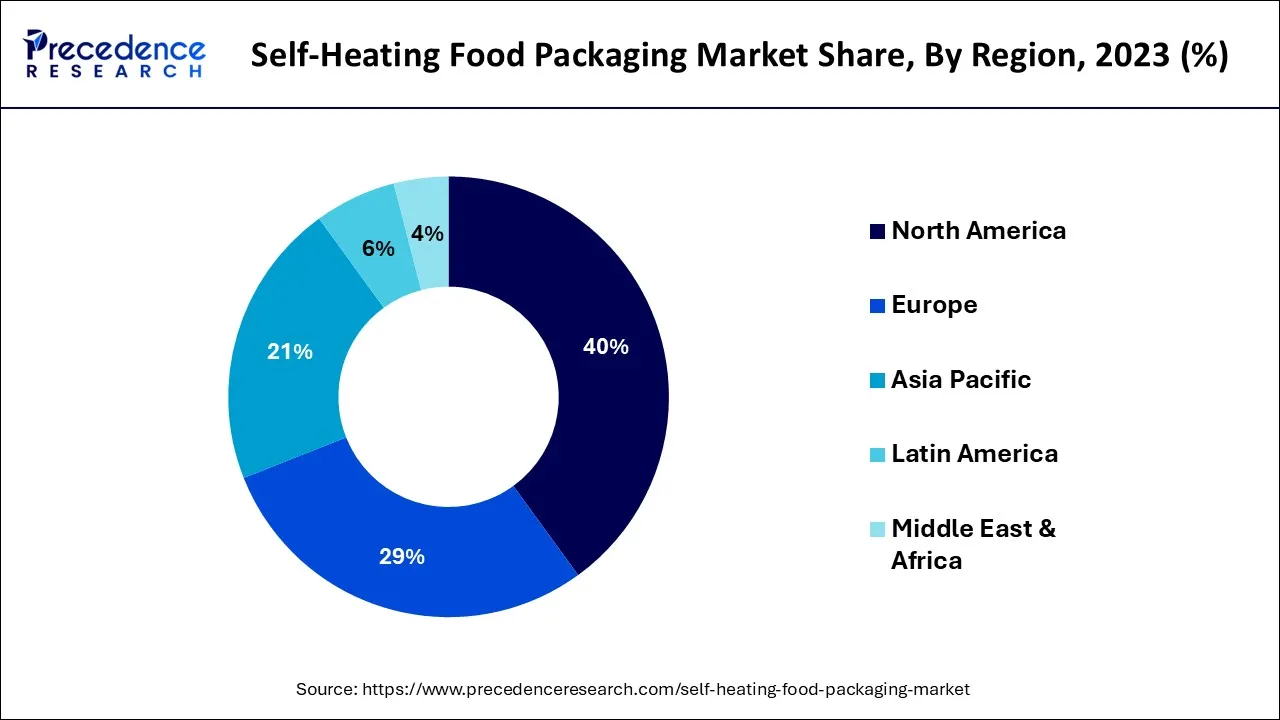January 2025
The global self-heating food packaging market size is predicted to increase from USD 63.81 billion in 2024, grow to USD 66.37 billion in 2025, and is anticipated to reach around USD 94.46 billion by 2034, poised to grow at a CAGR of 4% between 2024 and 2034. The North America self-heating food packaging market size is calculated at USD 25.52 billion in 2024 and is estimated to grow at the fastest CAGR of 4.13% during the forecast year.
The global self-heating food packaging market is expected to be valued at USD 63.81 billion in 2024 and is anticipated to reach around USD 94.46 billion by 2034, expanding at a CAGR of 4% over the forecast period from 2024 to 2034.

The U.S. self-heating food packaging market size is accounted for USD 17.87 billion in 2024 and is projected to be worth around USD 26.97 billion by 2034, poised to grow at a CAGR of 4.2% from 2024 to 2034.

North America: The world's three largest markets for self-heating food packaging are the United States, Canada, and Mexico. A recent analysis has found development opportunities in both European and Latin American (Mexico) areas (UK). Consumption increased more quickly starting in 2020 than it will in other regional markets like the Asia-Pacific due to increased knowledge of the health advantages of heated/cooked meals mixed with growing disposable income levels.
Due to their affluent metropolitan populations, Germany and France are the next major markets in Europe for self-heating food packaging items.

Consumer tastes, trends, and specialized interests have all been significant factors in the growth of the food and beverage industry. Due to rising customer demand for ready-to-eat, convenient, moderately processed food items with extended shelf lives and excellent quality standards, packaging trends in the food and beverage industry have also seen significant modification in recent years. Modern food packaging has undergone considerable modifications as a result of lifestyle changes, with self-heating food packaging becoming increasingly popular.
The packaging industry is rapidly eschewing old packaging methods in favour of more cutting-edge ones that have just lately been created such as, active packaging, intelligent packaging and bioactive packaging. Food packaging with the capacity to heat food components without the use of an external heat source is said to have self-heating capabilities. The exothermic process serves as the heat source for the self-heating food packaging.
The self-heating food packaging consists of two chambers: one for the heating unit and the other for food and drink storage. By pushing the button outside the packing, the heating unit is turned on. Quicklime and water are used in an exothermic chemical process to produce heat. Self-heating food packaging is typically used by military personnel, construction workers, and mountaineers in places where traditional cooking is not possible, but it is now becoming a regular practise among customers who are sluggish.
Additionally, self-heating food packaging is growing in favour among parents who must transport their children. In spite of the fact that the market for self-heating food packaging is still in its infancy, rising consumer awareness of its functionality and advantages is anticipated to lead to considerable demand over the course of the forecast period. Parents who must travel over long distances while carrying their infants are becoming more and more interested in self-heating food packing. The primary element accelerating the self-heating food packaging market expansion is the rise in demand for convenient food items and the level of life among consumers throughout the world.
The market for self-heating food packaging is being driven by a number of factors, including an expanding global food and beverage industry, a rise in the demand for wholesome on-the-go food items, an increase in the demand for ready-to-eat foods and confectionary foods and beverages like soups, tea, and coffee, rising food and beverage consumption, and changing consumer lifestyles. Furthermore, the market for self-heating food packaging will see new growth prospects as a result of increased technical breakthroughs, modernization of packaging processes, and growth in demand from emerging nations. In the future years, the market for self-heating food packaging is expected to develop under the effect of changing customer preferences.
Although there are other factors limiting market growth, the rise in the usage of chemical heat sources and government strict environmental pollution regulations are the main ones. These factors will make the economy for self-heating food packaging even more difficult to expand.
In many situations, including those involving the military, mountaineers, field engineers, and others when traditional cooking is not possible, self-heating food packaging is employed. The flameless ration self-heating container, which contains an integrated water triggered exothermic heater, is used by military troops to cook meals such as meats and other items. Within 12 minutes, the flameless ration self-heating container rises the temperature of its contents and immediately heats the meal. The magnesium metal and water undergo an exothermic reaction, which generates the heat used in this food packing. In addition, one of the widely used technologies for self-heating food packaging is heatgenie technology. The heatgenie is a typical heat source in food packaging that occupies 1 oz of the entire container capacity and is relatively adaptable. The aluminium and silica ingredient combine to generate heat, which is then transferred to the food within. Additionally, instantaneous heating of cold coffee into hot coffees is accomplished using the self-heating technology.
| Report Coverage | Details |
| Market Size in 2024 | USD 63.81 Billion |
| Market Size by 2034 | USD 94.46 Billion |
| Growth Rate from 2024 to 2034 | CAGR of 4% |
| Largest Market | North America |
| Base Year | 2023 |
| Forecast Period | 2024 to 2034 |
| Segments Covered | Packaging Type, End Users, Application, Distribution Channel, and Regions |
| Regions Covered | North America, Europe, Asia-Pacific, Latin America and Middle East & Africa |
The self-heating packaging market is anticipated to be dominated by the containers sector, which produced significant revenue in the year 2023. The self-heating container's increased appeal among travellers and how user-friendly it is might be contributed to the category growth. On the other hand, the cans category is anticipated to command a sizeable market share in the years to come due to its efficient heat up and portability. Additionally, producers are launching intelligent packaging tools including sensors, time-temperature indications, self-heating containers, and self-cooling containers. Incorporating electronic displays into this smart package. During the anticipated period, this aspect is anticipated to fuel market expansion for self-heating food packaging.
As end-users choose cans and bottles for the packaging of liquid items including soups, tea, and coffee, the beverages segment will experience profitable expansion throughout the projection period. The market for self-heating food packaging is expanding due in large part to customer demand for ready-to-eat foods, the rise of consumers who are always on the go, and rising consumer expenditure on packaged foods and beverages. Due to rising customer demand for ready-to-eat, convenient, moderately processed food items with extended shelf lives and excellent quality standards, packaging trends in the food and beverage industry have also seen significant modification in recent years. Moreover, the beverage industry has seen a greater increase in demand for self-heating food packaging. While revenues from drinks are anticipated to be higher for market participants in the self-heating food packaging industry, revenues from food are anticipated to grow significantly throughout the forecast period.
Segments covered in the report
By Packaging Type
By End Use
By Application
By Distribution Channel
By Geography
For inquiries regarding discounts, bulk purchases, or customization requests, please contact us at sales@precedenceresearch.com
No cookie-cutter, only authentic analysis – take the 1st step to become a Precedence Research client
January 2025
October 2024
January 2025
September 2024